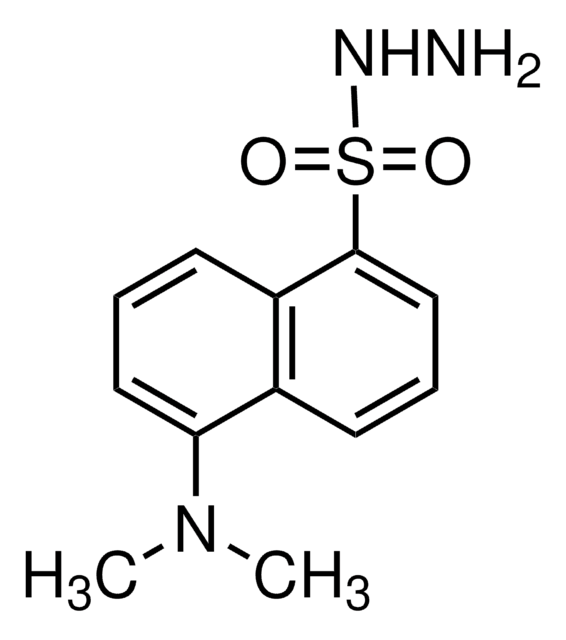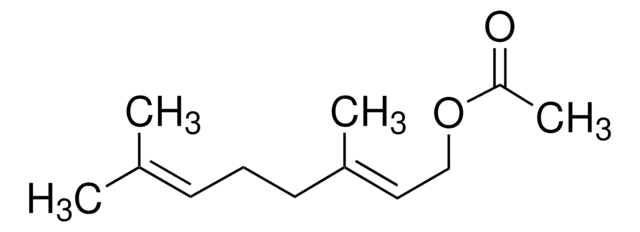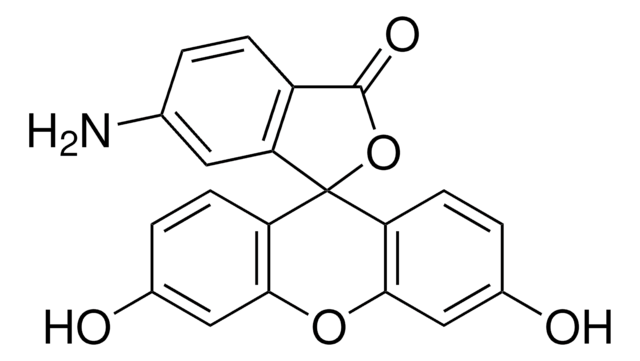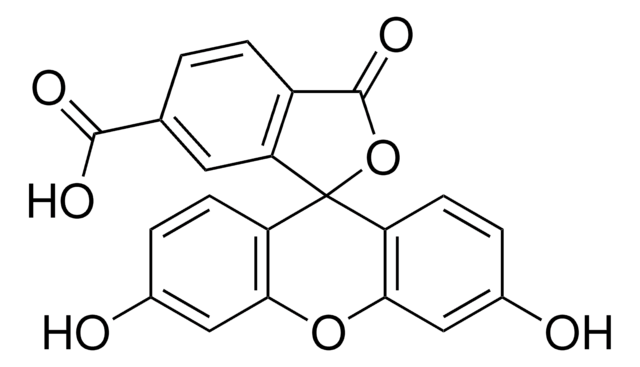46985
Fluorescein-5-thiosemicarbazide
suitable for fluorescence, ~80% (HPCE)
Sign Into View Organizational & Contract Pricing
All Photos(1)
About This Item
Empirical Formula (Hill Notation):
C21H15N3O5S
CAS Number:
Molecular Weight:
421.43
MDL number:
UNSPSC Code:
12352125
PubChem Substance ID:
NACRES:
NA.32
Recommended Products
Assay
~80% (HPCE)
Quality Level
form
solid
solubility
DMF: soluble
H2O: soluble
fluorescence
λex 492 nm; λem 516 nm in 0.1 M Tris pH 9.0
suitability
suitable for fluorescence
storage temp.
−20°C
SMILES string
NNC(=S)Nc1ccc(c(c1)C(O)=O)C2=C3C=CC(=O)C=C3Oc4cc(O)ccc24
InChI
1S/C21H15N3O5S/c22-24-21(30)23-10-1-4-13(16(7-10)20(27)28)19-14-5-2-11(25)8-17(14)29-18-9-12(26)3-6-15(18)19/h1-9,25H,22H2,(H,27,28)(H2,23,24,30)
InChI key
MEUCHQDLZYLNQY-UHFFFAOYSA-N
Related Categories
General description
Fluorescein-5-thiosemicarbazide, also known as FTC, is a fluorescent probe. The FTSC fluorescent spectra is like FITC, a preferred fluorescent tag for proteomics. The fluorescence spectral properties of FTSC-labeled vesicles obtained by reductive amination are fully compatible with the argon laser of fluorescent instruments.
Application
Fluorescein-5-thiosemicarbazide can be used as a fluorescent labeling reagent to label:
- Cell-surface functional groups (glycophorins) in the study of the effect of deoxygenation in the red blood cell membrane.
- Saccharides applicable in polysaccharide imaging in live cells.
- Chondroitin sulfate nanogels applicable in cell-specific drug delivery applications.
Features and Benefits
Fluorescein-5-thiosemicarbazide has the following benefits -
- It displays strong fluorescence property.
- Shows an intrinsic reactivity of the thiosemicarbazide group towards the aldehyde group.
Storage Class Code
11 - Combustible Solids
WGK
WGK 3
Flash Point(F)
Not applicable
Flash Point(C)
Not applicable
Personal Protective Equipment
dust mask type N95 (US), Eyeshields, Gloves
Choose from one of the most recent versions:
Already Own This Product?
Find documentation for the products that you have recently purchased in the Document Library.
Customers Also Viewed
One-pot fluorescent labeling of saccharides with fluorescein-5-thiosemicarbazide for imaging polysaccharides transported in living cells
Zhang Y, et al.
Carbohydrate Research, 346(14), 2156-2164 (2011)
Shinichi Nishimura et al.
PloS one, 8(12), e83716-e83716 (2014-01-05)
Cholesterol plays important roles in biological membranes. The cellular location where cholesterol molecules work is prerequisite information for understanding their dynamic action. Bioimaging probes for cholesterol molecules would be the most powerful means for unraveling the complex nature of lipid
Carina C Clingman et al.
eLife, 3 (2014-06-18)
Gene expression and metabolism are coupled at numerous levels. Cells must sense and respond to nutrients in their environment, and specialized cells must synthesize metabolic products required for their function. Pluripotent stem cells have the ability to differentiate into a
J D Corbett et al.
Biophysical journal, 66(1), 25-30 (1994-01-01)
We have used the fluorescence photobleaching recovery technique to study the dependence on oxygen tension of the lateral mobility of fluorescently labeled band 3, the phospholipid analogue fluorescein phosphatidylethanolamine, and glycophorins in normal red blood cell membranes. Band 3 protein
Hua Tian et al.
Journal of cellular and molecular medicine, 21(1), 107-120 (2016-08-12)
Oxidative stress and inflammation play important roles in the pathogenesis of cardiovascular disease (CVD). Oxidative stress-induced desialylation is considered to be a primary step in atherogenic modification, and therefore, the attenuation of oxidative stress and/or inflammatory reactions may ameliorate CVD.
Our team of scientists has experience in all areas of research including Life Science, Material Science, Chemical Synthesis, Chromatography, Analytical and many others.
Contact Technical Service












